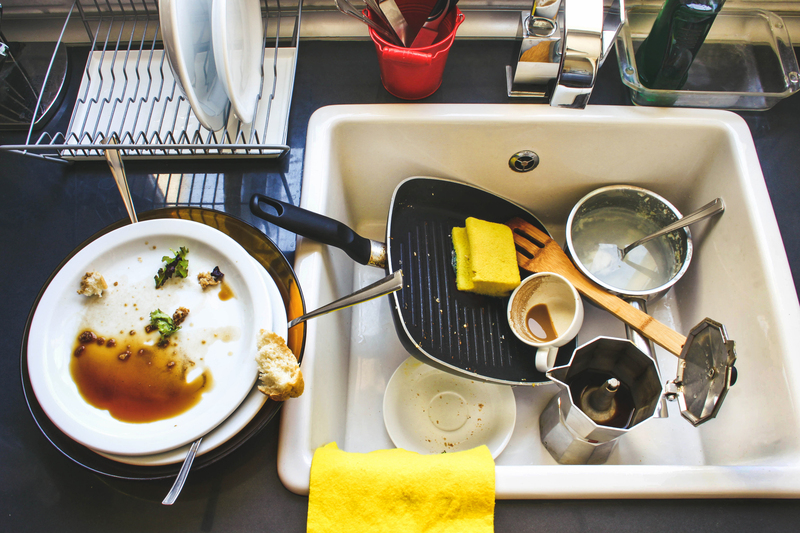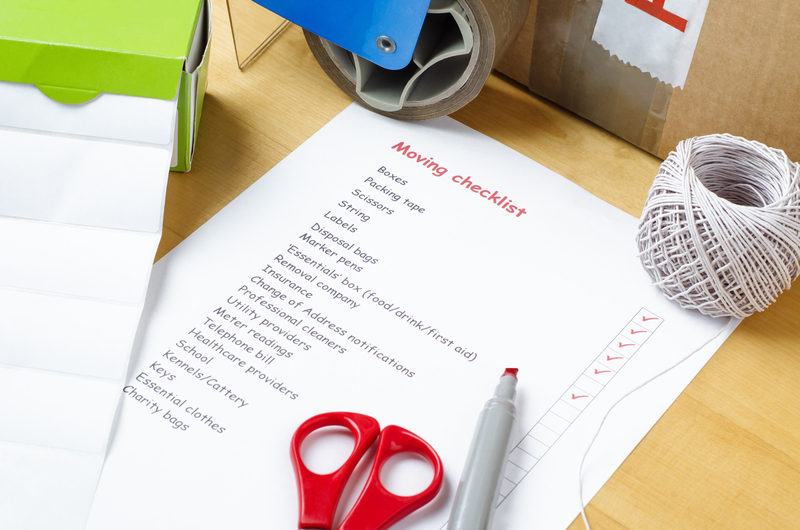Packing Secrets for a Smooth House Relocation
Posted on 11/06/2025
Packing Secrets for a Smooth House Relocation
Are you planning a house relocation? Packing up your entire life and moving to a new home can feel overwhelming. But with the right packing secrets and strategies, your move can be as smooth and stress-free as possible. Whether you're relocating across town or moving to a new city, this comprehensive guide will reveal indispensable packing tips and tricks for a seamless house relocation experience. Read on to learn how to pack your possessions smartly, avoid common mistakes, and enjoy the excitement of settling into your new abode!

Why Packing Correctly Is Essential for a Smooth Relocation
Packing intelligently doesn't just protect your belongings; it can also save you time, money, and energy. A well-organized move ensures that your house relocation goes off without a hitch and helps prevent broken items, misplaced boxes, and last-minute panics. Understanding the art of packing can transform your move into a streamlined process instead of a chaotic scramble.
- Efficiency: Smart packing helps you pack quickly and unpack easily.
- Protection: Correct packing safeguards your breakables and valuables.
- Cost Saving: Avoid overspending on packing supplies and moving services.
- Stress Reduction: Knowing your belongings are properly packed offers peace of mind.
Pre-Packing Preparation: Laying the Foundation for a Move
1. Create a Strategic Packing Plan
Before you even start boxing up your possessions, plan your move. This includes setting a moving date, arranging movers or a truck, and creating a packing timeline. Break your packing tasks into manageable chunks over several days or weeks, focusing on one room at a time.
- Decide what to pack first (seasonal items, rarely used decor).
- Set priorities for essential everyday items to pack last.
- Assign packing responsibilities if moving with family or roommates.
2. Declutter Before You Pack
One of the best packing secrets for a smooth house relocation is to declutter before you pack. Moving is the perfect opportunity to assess your belongings and get rid of items you no longer need or use. This not only simplifies your move but can also help reduce moving costs.
- Sell, donate, or recycle old clothes, furniture, books, and appliances.
- Dispose of broken, expired, or unnecessary items responsibly.
- Keep only the things that truly add joy or functionality to your new home.
3. Gather Essential Packing Supplies
Your packing will only be as good as your packing materials. Invest in sturdy boxes, packing tape, bubble wrap, packing paper, and markers. Don't forget specialty supplies like mattress bags, wardrobe boxes, and dish packs for extra protection.
- Stock up on strong, reinforced boxes in various sizes.
- Invest in bubble wrap, packing peanuts, and foam sheets for fragile items.
- Use stretch wrap to bundle furniture and prevent drawers from opening.
- Buy high-quality, wide packing tape.
- Have permanent markers, labels, and colored stickers for effective labeling.
Room-by-Room Packing Secrets for Flawless House Relocation
1. Master Bedroom Packing Tips
Packing up your sleeping sanctuary requires care, especially when it comes to clothing and bedding.
- Pack out-of-season clothes and shoes first.
- Use wardrobe boxes to keep clothes on hangers for easy transfer.
- Vacuum-seal bulky bedding to save space.
- Label every box with its contents and destination in the new home.
2. Living Room Packing Tricks
The living room often contains a mix of books, electronics, decor, and fragile items.
- Remove batteries and cables from electronics; use original boxes if possible.
- Wrap TVs and screens in bubble wrap and blanket them for extra cushioning.
- Pack books flat to prevent spine damage.
- Disassemble furniture and place screws and bolts in labeled bags attached to their corresponding items.
3. Kitchen Packing Hacks
The kitchen is often the hardest room to pack due to its abundance of fragile items and small gadgets.
- Start by packing infrequently used appliances and dishware.
- Use cell kits or dish packs for plates, glasses, and stemware.
- Wrap each piece individually with paper or bubble wrap.
- Label boxes with "FRAGILE" and an arrow indicating the correct orientation.
4. Bathroom Packing Ideas
Minimize leaks and messes by packing bathroom items correctly:
- Dispose of almost-empty or expired products before packing.
- Place liquids in sealed plastic bags to avoid spills.
- Box towels and linens together for a lightweight, cushiony load.
Packing "Gold" - Pro Secrets for a Smoother Move
1. Use the "First Day" Box Strategy
Pack an "essentials box" or "first night box" for the new house. This box should contain the items you'll need immediately upon arrival:
- Toiletries, medications, and a change of clothes.
- Phone and charger, basic kitchen items, and snacks.
- Important documents and small tool kit.
- Bedding and towels for the first night.
Keep this box with you rather than with the movers.
2. Color Code Your Boxes
Assign each room a color, and use labeled stickers, colored tape, or colored markers on the moving boxes. This visual system makes it simple to unload boxes into the correct rooms and helps speed up the unpacking process.
3. Take Photos for Electronics & Furniture Assembly
Before dismantling electronics or furniture, snap photos of cables and connections. These pictures act as an easy reference guide when setting up in your new home--saving you time and confusion.
4. Maximize Box Space, but Don't Overpack
Fill each box to its capacity to avoid crushing, but don't make them too heavy. A good rule of thumb: keep boxes under 50 pounds for easier handling.
- Use soft items (towels, linens) to pad fragile objects in boxes.
- Place heavier items at the bottom, lighter ones on top.
- Avoid mixing items from different rooms in one box--this makes unpacking much easier!
5. Secure Fragile Items with Extra Care
For glassware, ceramics, or artwork, employ several layers of packing paper or bubble wrap. Place a "fragile" warning on every side of the box. Pack plates vertically (like records) rather than stacking them to reduce breakage.
6. Utilize Suitcases and Drawers
Saves space and boxes by filling suitcases and duffle bags with clothes, books, or shoes. If feasible, transport dresser drawers with contents secured by plastic wrap, making reinstallation quick and easy.
7. Keep Hardware and Small Parts Labeled
Every time you disassemble furniture or appliances, collect and label all screws, bolts, and other small hardware in zipped bags. Tape these bags securely to the main item so pieces aren't lost in transit.
Special Considerations for Different Types of House Relocation
1. Apartment Moves
Often involve stairs, elevators, and tight spaces. Pack lighter boxes and disassemble bulky furniture to fit through doors easily.
2. Long-Distance Relocation
- Create an itemized inventory of all packed boxes and their contents.
- Focus on resilient packing methods, as items may be handled multiple times.
- Insure high-value, delicate, or irreplaceable possessions appropriately.
3. Relocating with Pets or Children
Pack a separate essentials kit for your pets and little ones, including their favorite toys, snacks, medications, and comfort items to make the transition easier.
A Few More Essential Packing Hacks
- Use towels and blankets as padding for mirrors and framed art.
- Bundle long items (curtain rods, brooms) together in moving pads or shrink-wrap.
- Don't pack hazardous materials (paint, aerosols, cleaning fluids) with other belongings.
- Plan for garbage bags and cleaning kits for a final sweep after everything is packed.
- Double-check attic, basement, and outdoor sheds for forgotten items.
Labeling and Inventory Management for Effortless Unpacking
Unpacking is often the most daunting part of a house relocation. But with proper labeling and a simple inventory system, you'll find your essentials in record time.
- Label each box clearly with its contents and destination room.
- Number your boxes and keep a list (physical or digital) of what's inside each box.
- Mark "Open First" on priority boxes.
- Keep a file of important documents, contracts, and inventory with you at all times.
Packing for a House Move: Common Mistakes to Avoid
- Packing too late--start sooner than you think necessary!
- Skipping the decluttering step and moving unnecessary items.
- Overfilling boxes, risking box breakage and injury.
- Forgetting to label--leading to confusion and misplaced belongings.
- Neglecting to properly protect fragile items.
Professional Packers vs DIY: What's Best for Your Relocation?
If your schedule is tight, or you have many delicate or high-value items, professional packers can be a smart investment for a smooth house relocation. They bring expertise, speed, and the right materials. However, with the right packing secrets and a step-by-step approach, a DIY move can be cost-effective and manageable for most households.
Advantages of Professional Packing Services
- Expertise in handling fragile and valuable items
- Save significant time
- Reduce risk of damage or loss
- Use of high-quality packing materials
When to DIY Your Packing
- You have plenty of time before moving day.
- You want to declutter thoroughly as you pack.
- You're moving on a tight budget.
- You have assistance from friends or family.

Final Steps: What to Do Once You're Packed
- Stage your boxes near the exit for easy loading.
- Confirm moving date and time with movers or truck rental.
- Do a final walkthrough to ensure nothing is left behind.
- Double-check utility disconnections and forwarding addresses.
Conclusion: Relocate Smoothly with These Expert Packing Secrets
House relocation doesn't have to be a source of stress. With these packing secrets for a smooth house relocation, you're equipped to tackle even the most daunting move with efficiency and confidence. Start early, stay organized, and follow these room-by-room tips and you'll enjoy a seamless transition to your new home. Remember--good packing is the cornerstone of every successful house move. Happy relocating!



